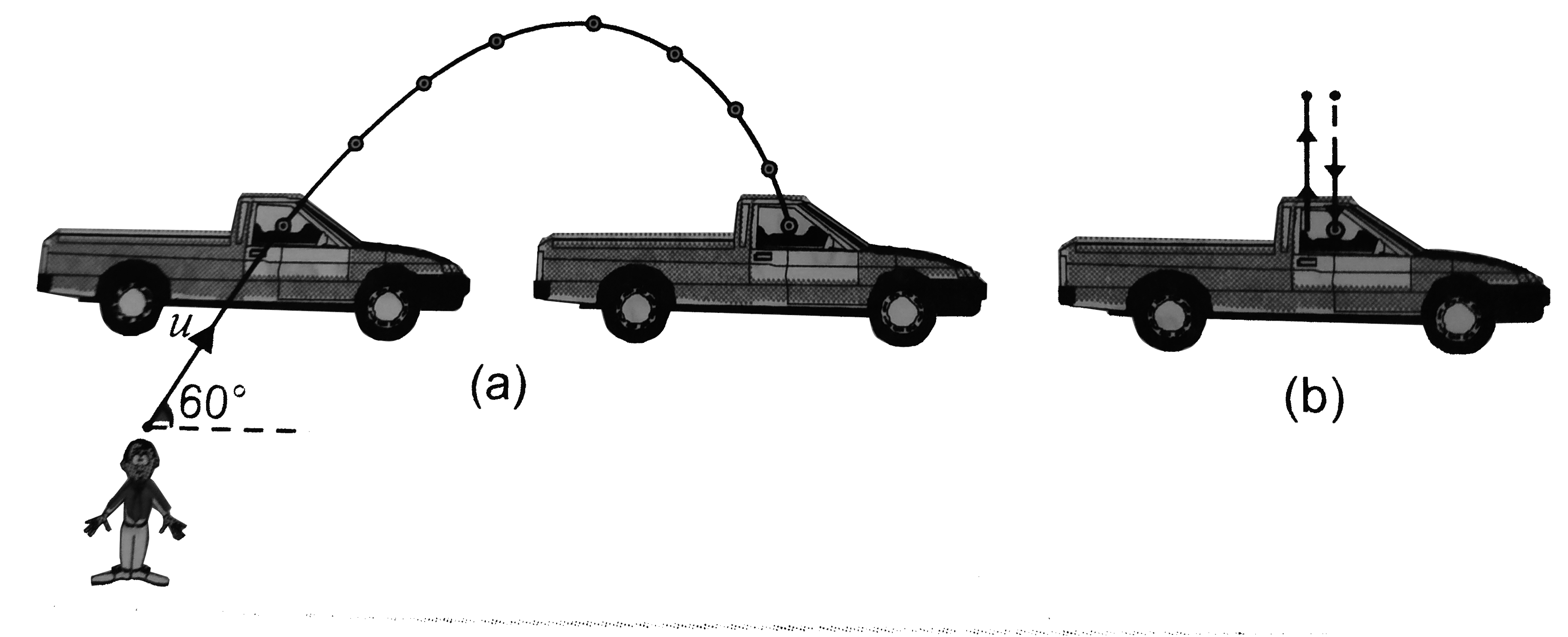A boy throws a ball in air at 60∘ to the horizontal along a road with a speed of 10m/s (km //h). Another boy sitting in a passing by car observes the ball. Sketch the motion of the ball as observed by the boy in the car, If car has a speed of (18 km //h). Give ezplanation to support your diagravm.
Hence, θ=60∘,u=10m/s
:. Horizontal component v elocity of ball ucosthera=10cos60∘=10×1/2=5m/s
Horizontal velocity of car
=18km/h
=5m/s
Sincen the speed of the car is matching with the horizontal speed of the projectile, hence boy sitting in the car will see only vertical motion of the ball, as shown in Fig. 2 (EP).2 20 (b).

Topper's Solved these Questions
- KINEMATICSBOOK - PRADEEPCHAPTER - KINEMATICSEXERCISE - 1 Long answer
2 Videos
- KINEMATICSBOOK - PRADEEPCHAPTER - KINEMATICSEXERCISE - 2 Long answer
3 Videos
- KINEMATICSBOOK - PRADEEPCHAPTER - KINEMATICSEXERCISE - 5 Short answer
6 Videos
- GRAVIATIONBOOK - PRADEEPCHAPTER - GRAVIATIONEXERCISE - Assertion-Reason Type Questions
19 Videos
- LAWS OF MOTIONBOOK - PRADEEPCHAPTER - LAWS OF MOTIONEXERCISE - Assertion- Reason Type Questions
17 Videos
Similar Questions
A boy travelling in an open car moving on a levelled road with constant speed tosses a ball vetically up in the air and catches it back. Shetch the motion of the ball as observed by a boy stanceing on the footpath. Give explanation to support your diagream.
View SolutionA ball is projected for maximum range with speed 20ms−1. A boy is located at a distance 25m from point of throwing start run to catch the ball at the time when the ball was projected. Find the speed of the boy so that he can catch the ball (Takeg=10ms−1).
View Solution
Knowledge Check
A car is running on a road at a uniform speed of 60 km/h . The net resultant force on the car is :
Adriving force in the direciton of car 's motion .BResistance force opposite to the direction of car's motion .Can inclined forceDequal to zeroConsider a car moving along a straight horizontal road with a speed of 72 km/h. If the coefficient of static friction between road and tyres is 0.5, the shortest distance in which the car can be stopped is
A30 mB40 mC72 mD20 mA ball was thrown by a boy a at angle 60∘ with horizontal at height 1 m from ground. Boy B is running in the plane of motion of ball and catches the ball at height 1 m from ground. He finds the ball falling vertically. If the boy is running at a speed 20 km/hr. Then the velocity of projection of ball is-
A20 km/hrB30 km/hrC40 km/hrD50 km/hr
A car moving along a straight highway with a speed of 72kmh−1 is brought to a stop within the distance of 100m. What is the retardation of the car and how long does it take for the car to stop ?
View SolutionA boy is moving with constant velocity 10m/s. A car starts from rest as the boy passes and accelerates at 5m/s2. After how much time and at what distance the car meets the boy? Sketch v-t and s-t graphs for the boy and car.
View SolutionConsider, a car moving along a straight horizontal road with a speed of 72 km/h. If the coefficient of static friction between the distance in which the car can be stopped is (Take g=10/s2)
View SolutionA boy throws a ball upward with velocity v0=20m/s. The wind imparts a horizontal acceleration of 4m/s2 to the left. The angle θ at which the ball must be thrown so that the ball returns to the boy's hand is : (g=10ms−2)
View SolutionA car is moving on a straight road covers one third of the distance with a speed of 20 km/h and the rest with a speed of 60 km/h. The average speed of the car is
View Solution
